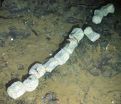Astrocyte signaling sheds light on stroke research
2013-03-18
(Press-News.org) BOSTON (March 18, 2013) — New research published in The Journal of Neuroscience suggests that modifying signals sent by astrocytes, our star-shaped brain cells, may help to limit the spread of damage after an ischemic brain stroke. The study in mice, by neuroscientists at Tufts University School of Medicine, determined that astrocytes play a critical role in the spread of damage following stroke.
The National Heart Foundation reports that ischemic strokes account for 87% of strokes in the United States. Ischemic strokes are caused by a blood clot that forms and travels to the brain, preventing the flow of blood and oxygen.
Even when blood and oxygen flow is restored, however, neurotransmitter processes in the brain continue to overcompensate for the lack of oxygen, causing brain cells to be damaged. The damage to brain cells often leads to health complications including visual impairment, memory loss, clumsiness, moodiness, and partial or total paralysis.
Research and drug trials have focused primarily on therapies affecting neurons to limit brain cell damage. Phil Haydon's group at Tufts University School of Medicine have focused on astrocytes, a lesser known type of brain cell, as an alternative path to understanding and treating diseases affecting brain cells.
In animal models, his research team has shown that astrocytes—which outnumber neurons by ten to one—send signals to neurons that can spread the damage caused by strokes. The current study determines that decreasing astrocyte signals limits damage caused by stroke by regulating the neurotransmitter pathways after an ischemic stroke.
The research team compared two sets of mice: a control group with normal astrocyte signaling levels and a group whose signaling was weakened enough to be made protective rather than destructive. To assess the effect of astrocyte protection after ischemic strokes, motor skills, involving tasks such as walking and picking up food, were tested. In addition, tissue samples were taken from both groups and compared.
"Mice with altered astrocyte signaling had limited damage after the stroke" said first author Dustin Hines, Ph.D., a post-doctoral fellow in the department of neuroscience at Tufts University School of Medicine. "Manipulating the astrocyte signaling demonstrates that astrocytes are critical to understanding the spread of damage following stroke."
"Looking into ways to utilize and enhance the astrocyte's protective properties in order to limit damage is a promising avenue in stroke research," said senior author Phillip Haydon, Ph.D. Haydon is the Annetta and Gustav Grisard professor and chair of the department of neuroscience at Tufts University School of Medicine and a member of the neuroscience program faculty at the Sackler School of Graduate Biomedical Sciences at Tufts.
###
Research reported in this publication was supported by the National Institute of Neurological Disorders and Stroke and the National Institute of Mental Health, both of the National Institutes of Health under award numbers R01NS037585 and R01MH095385, respectively. Dustin Hines was partially funded by the Heart and Stroke Foundation of Canada. Haydon is the co-founder and president of GliaCure Inc., which has licensed a pending patent application filed by Tufts University related to work described in this paper.
Hines, D.J., Haydon, P.G. (2013). Inhibition of a SNARE-Sensitive Pathway in Astrocytes Attenuates Damage following Stroke. The Journal of Neuroscience, vol 33 issue 10, pp 4234-4240; DOI: 10.1523/JNEUROSCI.5495-12.2013
About Tufts University School of Medicine and the Sackler School of Graduate Biomedical Sciences
Tufts University School of Medicine and the Sackler School of Graduate Biomedical Sciences at Tufts University are international leaders in innovative medical education and advanced research. The School of Medicine and the Sackler School are renowned for excellence in education in general medicine, biomedical sciences, special combined degree programs in business, health management, public health, bioengineering and international relations, as well as basic and clinical research at the cellular and molecular level. Ranked among the top in the nation, the School of Medicine is affiliated with six major teaching hospitals and more than 30 health care facilities. Tufts University School of Medicine and the Sackler School undertake research that is consistently rated among the highest in the nation for its effect on the advancement of medical science.
ELSE PRESS RELEASES FROM THIS DATE:
2013-03-18
A new study from the University of Maryland School of Medicine suggests that depression results from a disturbance in the ability of brain cells to communicate with each other. The study indicates a major shift in our understanding of how depression is caused and how it should be treated. Instead of focusing on the levels of hormone-like chemicals in the brain, such as serotonin, the scientists found that the transmission of excitatory signals between cells becomes abnormal in depression. The research, by senior author Scott M. Thompson, Ph.D., Professor and Interim Chair ...
2013-03-18
Bochum, 18.3.2013
In the fruit fly Drosophila, the functions of the three enzymes Tan, Ebony and Black are closely intertwined - among other things they are involved in neurotransmitter recycling for the visual process. RUB researchers from the Department of Biochemistry showed for the first time that flies cannot see without this recycling. Their analysis of the enzyme Black also raises new questions as to its function. Anna Ziegler, Florian Brüsselbach and Bernhard Hovemann report in the „Journal of Comparative Neurology", which chose this topic as cover story.
Tan, ...
2013-03-18
A new online database combining symptoms, family history and genetic sequencing information is speeding the search for diseases caused by a single rogue gene. As described in an article in the May issue of Human Mutation, the database, known as PhenoDB, enables any clinician to document cases of unusual genetic diseases for analysis by researchers at the Johns Hopkins University School of Medicine or the Baylor College of Medicine in Houston. If a review committee agrees that the patient may indeed have a previously unknown genetic disease, the patient and some of his or ...
2013-03-18
Daejeon, Republic of Korea, March 18, 2013 -- Nonvolatile memory that can store data even when not powered is currently used for portable electronics such as smart phones, tablets, and laptop computers. Flash memory is a dominant technology in this field, but its slow writing and erasing speed has led to extensive research into a next-generation nonvolatile memory called Phase-Change Random Access Memory (PRAM), as PRAM's operating speed is 1,000 times faster than that of flash memory.
PRAM uses reversible phase changes between the crystalline (low resistance) and amorphous ...
2013-03-18
Milan, 18 March 2013 – Markers such as CA9, CD31, CD34 and VEGFR1/2 in the primary tumours might serve as predictors of a good response to a sunitinib treatment in patients with metastatic clear cell renal cell carcinoma (ccRCC), according to a new study to be presented at the 28th Annual EAU Congress currently on-going in Milan.
"The inactivation of the von Hippel-Lindau gene (VHL) is a common event in ccRCC and finally leads to the induction of HIF1α target genes such as CA9 and VEGF," write the authors. "Besides VEGF, the VEGF and PDGF receptors also play an important ...
2013-03-18
Drs Lewis and Carré in the University's Department of Mechanical Engineering have been measuring the dynamic friction between the material of the ball and the skin on the fingertips and palm, and the mitts that some players choose to wear under different weather conditions. They're looking to answer one question: what's the best way to ensure that players don't fumble the ball?
"Catching and handling a ball with great skill and confidence is practically second nature to players at this level," says Dr Lewis. "But handling errors are still seen in professional rugby games ...
2013-03-18
CORAL GABLES, FL (March 18, 2012) -- University of Miami (UM) doctoral student in Environmental Science and Policy, David Shiffman was invited to tweet updates in real-time, at the International Congress of Conservation Biology, New Zealand, 2011. As a result, more than 100,000 twitter users worldwide saw at least one tweet from the conference, and nearly 200 people from more than 40 countries, on six continents shared at least one tweet from the conference -- greatly exceeding the number of conference attendees.
"While live-tweeting is not a new phenomenon, ...
2013-03-18
Marine biologists have, for the first time, found a whale skeleton on the ocean floor near Antarctica, giving new insights into life in the sea depths. The discovery was made almost a mile below the surface in an undersea crater and includes the find of at least nine new species of deep-sea organisms thriving on the bones.
The research, involving the University of Southampton, Natural History Museum, British Antarctic Survey, National Oceanography Centre (NOC) and Oxford University, is published today in Deep-Sea Research II: Topical Studies in Oceanography.
"The planet's ...
2013-03-18
The scientists looked at glaciers which behave independently from the ice sheet, despite having some physical connection to it, and those which are not connected at all.
The discovery, just published in Geophysical Research Letters, is important as it will help scientists improve the predictions of the future contribution of Greenland's ice to sea-level rise.
Using lasers which measure the height of the ice from space, and a recently completed inventory of Greenland's glaciers and ice caps, scientists from the European-funded ice2sea programme, were able to determine ...
2013-03-18
Washington, D.C.— It has long been believed that male lions are dependent on females when it comes to hunting. But new evidence suggests that male lions are, in fact, very successful hunters in their own right. A new report from a team including Carnegie's Scott Loarie and Greg Asner shows that male lions use dense savanna vegetation for ambush-style hunting in Africa. Their work is published in Animal Behavior.
Female lions have long been observed to rely on cooperative strategies to hunt their prey. While some studies demonstrated that male lions are as capable at hunting ...
LAST 30 PRESS RELEASES:
[Press-News.org] Astrocyte signaling sheds light on stroke research



